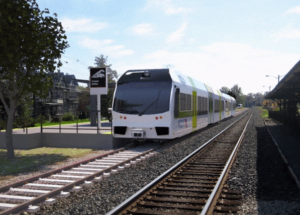Writer: Joshua Andino
 2 min read November 2022 — With the selection of South Jersey Transit Partners to provide engineering and professional services in the development of the Glassboro-Camden light rail line, Invest: examines where the project is today and what remains to be done.
2 min read November 2022 — With the selection of South Jersey Transit Partners to provide engineering and professional services in the development of the Glassboro-Camden light rail line, Invest: examines where the project is today and what remains to be done.
The project, which was initially announced in 2009 and had seen a series of fits and starts, is moving forward, with the joint venture between AECOM and STV Inc., South Jersey Transit Partners (SJTP), being selected by the Glassboro-Camden Line (GCL) team to provide preliminary engineering and design (PED), project management and professional services for the pre-construction phase of the light rail line.
“This will take cars off the roads and give students a better commuting option that also offers unique connections to both Philadelphia and New York,” explained Marlene Asselta, president of the Southern New Jersey Development Council on the benefits of the LRT’s expansion, in her interview with Invest:.
Bane Gaiser, chief executive of AECOM’s U.S. East and Latin America region, said in a statement that “The GCL is an important initiative to improve mobility by offering quick, reliable, and frequent rail service to the region.” He added, “Our SJTP joint venture is incredibly proud to continue our crucial work, leveraging our deep understanding of the GCL Project Team’s objectives, the project’s scope, stakeholder engagement and public needs to successfully deliver a transportation option that will have a positive impact on the day-to-day lives of South Jerseyans.”
The project would restore rail service along a pre-existing rail-line, beginning at Walter Rand Transportation Center in Camden – undergoing its own renovations – and head 18 miles south to Glassboro. The GCL is expected to provide an easy connection between educational centers such as Rowan University and Rutgers University’s Camden campus alongside communities such as Gloucester City, Woodbury and Pitman, with a total of 14 proposed stops.
Stephen Dougherty, executive director of the South Jersey Transportation Authority and one of the project partners alongside the Delaware River Port Authority and New Jersey Transit managing the GCL project, explained that it was critical to strike a balance between efficient transit development and the community’s concerns around the environment.
“One of the big challenges in transportation is to improve our assets while also maintaining the high-quality environment we are used to in South Jersey. There are a lot of environmental challenges like climate change, resiliency and making sure everything we do can stand the test of time. I think one of the big things we are seeing, especially as different areas of the state are growing, is that the rail line is going to be a huge improvement. Folks who would normally have a 40-minute commute will decrease their travel time dramatically. It will have a positive impact on the environment as well as the local economy,” Dougherty said.
The PED phase will provide the project’s overall strategic construction plan and include design specifications, contracts, the acquisition of rights-of-way, as well as the necessary utility and geographic studies and is anticipated to last three years. Overall, the project’s price tag is estimated to fall between $1.6 and $1.8 billion.
While plenty of time remains before South Jerseyans can take the fabled rail link from Glassboro to Camden and to Philadelphia or New York beyond, Asselta told Invest: that the project would be key as younger generations settle in the region and hope to ditch their cars. “While some older residents have pushed back on this type of infrastructure growth in their neighborhoods, our data shows that younger homeowners feel the opposite. They want proximity to transportation hubs and are less likely to own a car, so a train service like this would be optimal,” she said.
With an expected completion in 2028, the GCL will provide a vital rail link for the region that will continue to grow while still aiming to maintain South Jersey’s idyllic character.
“The best solution for our region is to keep development centered around areas already served by the infrastructure that is needed. Whether that’s for water and sewer, or access to highways and rails, we want to keep that development on brownfields instead of encroaching on our greenfields,” Asselta noted.
For more information, visit:

